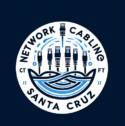What Are the Important Parts Needed to Install a Network?
If you’re planning to set up a new network — whether for your home, office, or commercial building — it’s important to understand the key parts that make everything work together. A reliable network isn’t just about connecting cables and routers. It’s about having the right components installed properly to ensure speed, stability, and security.
Let’s break down the important parts needed to install a network, why each one matters, and how they all work together to keep your systems running smoothly. Our professional network cabling specialists in Santa Cruz ensure that every component—from cables to connectors—is properly installed for reliable performance.
1. Network Cables
Network cables are the foundation of any wired network. They connect your devices, servers, and routers so data can travel quickly and efficiently.
Common cable types include:
- CAT6 or CAT6a cables – Ideal for most modern offices and homes; support Gigabit or 10-Gigabit Ethernet.
- Fiber optic cables – Used in high-performance networks that need fast data transmission over long distances.
- Patch cables – Short cables that connect devices to patch panels or network switches.
Choosing the right cable depends on your speed requirements, distance, and environment.
2. Network Switch
A network switch acts like the traffic controller of your network. It connects multiple devices (like computers, printers, and access points) within the same local area network (LAN) and ensures data is sent to the correct destination.
There are two main types of switches:
- Unmanaged switches – Simple plug-and-play models for small networks.
- Managed switches – Offer advanced features like VLANs, traffic monitoring, and better security — ideal for business networks.
3. Router
The router connects your local network to the internet. It directs incoming and outgoing data between devices and external networks.
Modern routers often include features like:
- Built-in Wi-Fi for wireless connectivity
- Firewall protection for security
- Dual-band or tri-band technology for faster performance
- VPN support for remote work or secure connections
For businesses, enterprise-grade routers offer stronger performance and advanced configuration options.
4. Modem
A modem (short for modulator-demodulator) provides the link between your network and your internet service provider (ISP). It converts digital signals from your router into a format suitable for your ISP’s network and vice versa.
In some setups, routers and modems are combined into a single device — but in larger networks, they’re usually separate for better control and performance.
5. Patch Panel
A patch panel organizes and connects network cables in one central location, typically inside a rack or wall cabinet. It allows for easy management, testing, and maintenance without having to move cables around constantly.
Patch panels are essential in structured cabling systems because they make it easy to identify connections, reroute cables, and expand the network later on.
6. Access Points (Wireless)
If you need Wi-Fi coverage throughout your building, wireless access points (APs) are a must. These devices extend your wireless range and provide fast, stable connections for laptops, smartphones, and IoT devices.
For large areas — like schools, warehouses, or offices — multiple APs can be strategically placed to ensure seamless coverage without dead zones.
7. Network Rack or Cabinet
A network rack houses essential networking equipment like switches, patch panels, routers, and UPS units. It keeps everything organized, secure, and properly ventilated.
Cable management accessories (like trays, ties, and Velcro straps) also help maintain a clean setup that’s easy to troubleshoot and expand. Before starting, make sure you have the right equipment. Check out the essential tools needed for LAN cables to complete your setup efficiently.
8. Power Supply and UPS
Reliable power is crucial for any network. Installing a UPS (Uninterruptible Power Supply) ensures that your system keeps running during short power outages or surges.
A UPS helps:
- Prevent data loss
- Protect equipment from voltage spikes
- Keep servers and routers online long enough to shut down safely
9. Network Interface Cards (NICs)
Each device connected to a wired network needs a network interface card or NIC. This hardware component allows the device to communicate with the network. Most modern computers come with built-in NICs, but for higher-speed connections, you may need upgraded or additional network cards.
10. Testing and Certification Tools
After installation, every cable and connection should be tested with proper network certification tools. These tools verify that your cables meet industry standards (like TIA/EIA-568) and perform at the correct speeds.
Testing ensures your network runs smoothly and prevents future performance issues.
Why Professional Installation Matters
While DIY network setups work for small homes, larger or commercial projects require professional installation. Certified network cabling contractors understand California’s low-voltage regulations, grounding requirements, and best practices for cable routing and labeling.
Professionals ensure that your network:
- Meets industry standards and safety codes
- Is properly organized for future upgrades
- Runs efficiently with minimal interference or downtime
Final Thoughts
Installing a reliable network takes more than just connecting a few cables. From switches and routers to access points and patch panels, every part plays a vital role in performance and stability.
Whether you’re setting up a small business or building an enterprise-level system, understanding these important parts of a network installation helps you make informed decisions and invest in long-lasting solutions. Once your network is set up, learn what’s required to connect a network cable to a computer for a smooth connection.
For the best results, work with a licensed structured cabling professional who can design, install, and test your system for maximum reliability.
